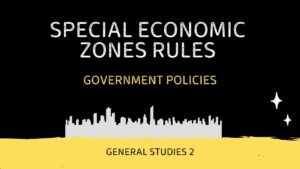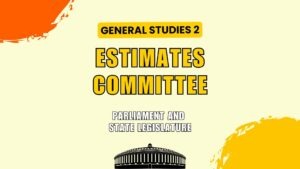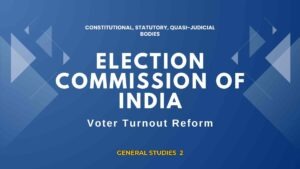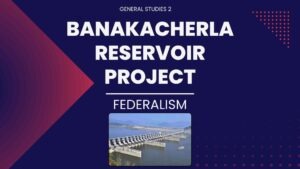Banakacherla Reservoir Project - Important Notes for UPSC
Banakacherla Reservoir Project
🧭 In News:
A fresh inter-state water dispute has arisen between Andhra Pradesh (AP) and Telangana over the proposed Banakacherla Reservoir Project, with Telangana alleging that the project violates the Andhra Pradesh Reorganisation Act, 2014 and bypasses essential regulatory approvals.
📌 About Banakacherla Reservoir Project:
| Feature | Description |
|---|---|
| Location | Banakacherla, Nandyal district, Andhra Pradesh |
| Purpose | To divert surplus water from the Godavari River to drought-prone Rayalaseema region |
| Type | Irrigation and inter-basin river-linking project |
| Rivers Involved | Godavari → Krishna → Penna |
| Executing State | Andhra Pradesh |
| Objecting State | Telangana |
🛠️ Project Components:
🔄 River Diversion & Canal Enhancements:
Polavaram Right Main Canal: Capacity increase from 17,500 cusecs → 38,000 cusecs
Thatipudi Lift Canal: Capacity increase from 1,400 cusecs → 10,000 cusecs
New Reservoir at Bollapalli
Water lifted and tunneled through Nallamala forest to Banakacherla
🏗️ Lift Irrigation Points:
Five major lift stations:
Harischandrapuram
Lingapuram
Vyyandana
Gangireddypalem
Nakirekallu
🌊 Interlinking of Rivers:
Transfers surplus Godavari water via Krishna to Penna Basin
Aims to address chronic water scarcity in Rayalaseema
🚨 Issues Raised by Telangana:
⚖️ Legal and Regulatory Violations:
Andhra Pradesh Reorganisation Act, 2014
Mandates prior approvals for inter-basin transfers and major irrigation projects
No clearance from central agencies:
Krishna River Management Board (KRMB)
Godavari River Management Board (GRMB)
Central Water Commission (CWC)
📉 Concerns on Water Allocation:
The Godavari Water Disputes Tribunal allocated 968 TMCft to Telangana out of 1,486 TMCft.
Telangana alleges improper surplus estimation and diversion without formal consent
🚧 Impact on Telangana’s Irrigation Projects:
May affect:
Ongoing and proposed irrigation schemes in Telangana
Water availability in existing reservoirs depending on Godavari inflows
🧮 Relevant Institutions and Legal Framework:
| Institution | Role |
|---|---|
| CWC | Technical advisory body under Ministry of Jal Shakti |
| KRMB/GRMB | Set up post-2014 for managing Krishna and Godavari river waters between AP and Telangana |
| Inter-State River Water Disputes Act, 1956 | Governs water-sharing conflicts among states |
| Andhra Pradesh Reorganisation Act, 2014 | Mandates equitable resource sharing between Telangana and Andhra Pradesh post-bifurcation |
🔍 Broader Significance:
Reflects ongoing challenges in river water federalism in India
Highlights the growing tension over water security amid climate variability and regional imbalances
Raises concerns about environmental clearance and forest conservation, particularly in the Nallamala forest region (tiger corridor)
🧾 Prelims Pointers:
Banakacherla Project is a proposed inter-basin transfer scheme involving Godavari, Krishna, and Penna rivers.
Located in Nandyal district, Andhra Pradesh.
Telangana cites violation of Andhra Pradesh Reorganisation Act, 2014.
No approvals yet from CWC, KRMB, or GRMB.
Nallamala forest (tiger corridor) involved in tunnel construction.
Mains-Based Questions on Banakacherla Reservoir Project
✅ Q1. Inter-state river disputes have become increasingly frequent in India. Critically examine this statement in the context of the Banakacherla Reservoir Project controversy.
Answer Framework:
Introduction:
Mention the growing number of inter-state river disputes.
Introduce Banakacherla as the latest flashpoint between Andhra Pradesh and Telangana.
Body:
🔹 Nature of the Banakacherla Dispute:
Unilateral project by Andhra Pradesh to divert surplus Godavari water.
Telangana’s objections: violation of the Reorganisation Act, no central clearances, threat to its own irrigation projects.
🔹 Legal/Regulatory Concerns:
Andhra Pradesh Reorganisation Act, 2014 mandates prior approvals.
Lack of clearance from CWC, KRMB, GRMB.
No finalization of surplus water availability.
🔹 Why Such Disputes Arise Frequently:
Absence of permanent water-sharing mechanisms.
Delay in adjudication by tribunals.
Rising water stress and climate-induced scarcity.
Political populism in water allocation.
🔹 Consequences:
Tension and mistrust between states.
Project delays and underutilization of water potential.
Ecological degradation (e.g., Nallamala forest in this case).
Conclusion:
Strengthening of river boards, timely tribunal awards, and cooperative water governance are essential to resolve such disputes sustainably.
✅ Q2. Examine the constitutional, legal, and institutional mechanisms available to resolve inter-state water disputes in India. Why do conflicts like the Banakacherla project persist despite these provisions?
Answer Framework:
Introduction:
Water is in the State List, but inter-state rivers fall under Union oversight (Entry 56, Union List).
Mention the Banakacherla dispute to highlight ongoing challenges.
Body:
🔹 Constitutional Provisions:
Article 262: Parliament may provide for adjudication of inter-state river disputes.
Entry 56, Union List: Parliament’s power to regulate inter-state rivers.
🔹 Legal Mechanisms:
Inter-State River Water Disputes Act, 1956
Andhra Pradesh Reorganisation Act, 2014
🔹 Institutional Mechanisms:
Tribunals (e.g., Godavari, Krishna Water Disputes Tribunal)
River Management Boards (KRMB, GRMB)
Central Water Commission (CWC)
🔹 Challenges Despite These Mechanisms:
Delays in forming and implementing tribunal awards.
Boards have advisory, not binding powers.
Politicization of water issues.
Lack of consensus on surplus water definitions.
Conclusion:
Institutional strengthening and binding mechanisms are needed.
National Water Policy should emphasize cooperative federalism and data transparency.
✅ Q3. Discuss the environmental implications of inter-basin river-linking projects in India with special reference to the Banakacherla Reservoir Project.
Answer Framework:
Introduction:
Mention India’s push for interlinking rivers to address regional water imbalances.
Introduce Banakacherla as an inter-basin Godavari–Krishna–Penna linking project.
Body:
🔹 Environmental Implications:
Disturbance of ecological balance in donor and recipient basins.
Altered river flow affecting aquatic biodiversity.
Deforestation and wildlife impact (Nallamala forest in Banakacherla case).
🔹 Banakacherla-Specific Issues:
Tunnel construction through ecologically sensitive zones.
Impact on wildlife corridors, especially tigers.
Absence of proper Environmental Impact Assessment (EIA).
🔹 Broader Concerns:
Cumulative impact on monsoon cycles, sediment flow, and river rejuvenation.
Risk of displacement and submergence in tribal areas.
Conclusion:
Inter-basin transfers must be undertaken only after rigorous EIAs and public consultations.
Sustainable development must guide future river-linking projects.
✅ Q4. Critically analyze the role of the Andhra Pradesh Reorganisation Act, 2014 in resolving post-bifurcation water-sharing conflicts. Has it been effective?
Answer Framework:
Introduction:
AP Reorganisation Act, 2014 aimed at equitable sharing of resources between Telangana and Andhra Pradesh.
Water disputes like the Banakacherla issue test its effectiveness.
Body:
🔹 Provisions in the Act:
Establishment of KRMB and GRMB
Mandate for prior approvals for new irrigation projects
Equitable distribution of water and other resources
🔹 Challenges in Implementation:
Disputes over water allocations and project approvals
Boards lack enforcement powers; often bypassed
Delayed Centre intervention
🔹 Effectiveness:
Partial success in institutional setup
Weak enforcement and poor inter-state coordination
Frequent bypassing of legal provisions (e.g., Banakacherla)
Conclusion:
The Act needs strengthening through clearer guidelines, binding powers to river boards, and central mediation mechanisms for long-term effectiveness.
Prelims Questions based on Banakacherla Reservoir Project
-
Special Economic Zones Rules – Important UPSC Notes
The Government of India has recently relaxed certain provisions of... -
National Conference of Estimates Committees – Important UPSC Notes
Lok Sabha Speaker inaugurated the National Conference of Estimates Committees... -
Election Commission of India – Important UPSC Notes
The Election Commission of India (ECI) has launched a tech-driven... -
Banakacherla Reservoir Project – Important UPSC Notes
A fresh inter-state water dispute has arisen between Andhra Pradesh... -
India-Japan Maritime Relation – Important UPSC Notes
India and Japan have intensified bilateral maritime collaboration (India-Japan Maritime... -
UNESCO Global Education Monitoring (GEM) Report
The UNESCO Global Education Monitoring (GEM) Report 2024–25 highlights that... -
Registered Unrecognised Political Parties – Important UPSC Notes
The Election Commission of India (ECI) has initiated the delisting... -
Viksit Bharat Ka Amrit Kaal Report – Important UPSC Notes
Viksit Bharat Ka Amrit Kaal Report - Important Notes for...









